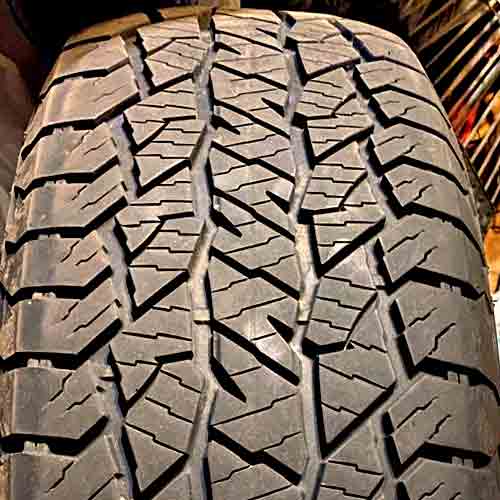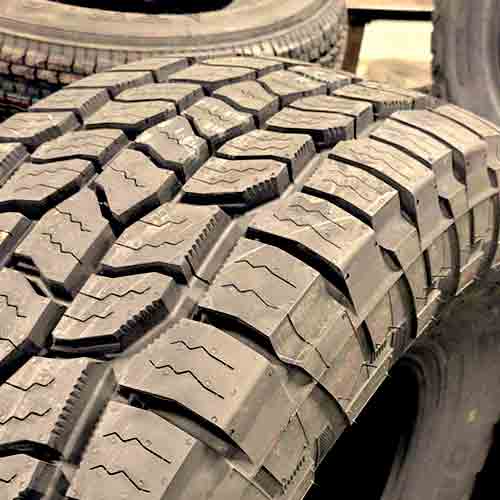Both the Hankook Dynapro AT2 and the Cooper Discoverer AT3 XLT, give you a very suitable and reliable options for your light truck and full sized SUV, as they offer a great balance between traction and comfort. Though one tire still gets to be better over the other in some sections. Let’s find out.

As a tire engineer, I can tell that the Hankook AT2 is a better tire to have on (dry) roads, where you’d also be amazed with its tread life. The Cooper AT3 on the other hand, does better with wet highways, fuel economy, and even off-road traction (well, except for rocky terrains).
Detailed Review on Cooper Discoverer AT3.
Tread Design
Starting with the Hankook Dynapro AT2.

So this tire features a 5-rib design with the innermost rib being slightly wider and exhibiting sideways-facing notches.
(With wider blocks there, basically the tire is able to meet up with the road more, and so better directional grip is achieved).
Moreover, this central (most) rib has a secondary continuous layer running underneath, and to which all the lugs are attached. So that means the lateral grooves made there are not all the way, so although this affects the self cleaning of the tread, it provides traction.
The surrounding lugs are more open, and present with similar groove notches as well.
Moving towards sides, the carry similar attributes like the rest of the blocks, as they have off-set edges, and biters, however, they feature a less aggressive siping design compared to the central lugs, which exhibit a full-depth pattern allowing the lugs to split open. And yes, they also don’t have the stepped edges as seen on the central blocks, either.
But then again this compromise in biters bring for maximum highway grip, while all lugs connected together with ridges in between enhance lateral stability, and steering communication.
Though I really miss the sidewalls on this tire, as they come in really handy with lowered air pressure.
The Cooper Discoverer AT3 on the other hand, is also a very well aligned tire for highways.

If I start things off from the middle, here you see 4 longitudinal ribs just like it’s competitor, though they include more “squared-off” and running in pairs (as they are connected together from underneath).
All 3 ribs are almost of equal proportions, but they are sightly more packed up, that’s why the outer circumferential grooves are a little wider and border the sides of the tire.
They all also carry similar features as well, including foundational supports of secondary layers, and full depth interlocking siping, though on the surrounding ribs, blocks also have snow vices (sharp-teeth). I’ll discuss them in “winter performance” section.
Same goes for the shoulder lugs, though they are slightly bigger/elongated, they carry similar features of snow vices, interlocking sipes and foundational supports.
And although they seem to have wider lateral grooves in between, they are placed with ridges for on-road performance (in terms of noise and traction). Cooper calls them Whisper grooves.
Tire’s Toughness
All-terrain tires are made tough, mostly though their internal construction, where a little part is also contributed with the tread’s composition, depth, and it’s resistance to cuts.
And so out of both tires, the Hankook Dynapro AT2 with it’s 3 ply polyester casing gets to be tougher.
Whereas the Cooper Discoverer AT3 although has 2 ply sidewalls, it still not too far off, as it’s thicker lugs on top, provides decent protection to the weakest part of the tire.
Side Note: Out of both tires, only Cooper AT3 made it to my list of top A/T tires, check here: https://tiredriver.com/best-all-terrain-tires/
Dry Roads Performance
To comprehend the dry performance of an all-terrain tire, traction, steering, and cornering capability are all essential elements to consider. Let’s delve deeper into these key factors.
Dry Grip
The overall dry grip of a tire is the basic form of on-road traction (a small part), and it gets calculated by braking distances. Here the middle part of the tread (which carries the most weight while moving straight), weight and tread composition plays a great role.
And looking at all, it can be seen why both tires are similar here.
Hankook Dynapro AT2 has a greater weight, which produces a larger moving inertia, meaning, its requires more force to stop, though at the same time, it’s harder compound keeps its lugs stable, and it’s smaller tread depth adds to that.
Cooper Discoverer AT3 XLT on the other side, has a softer composition, but it offer slighter greater footprint to be in contact with the surface, and it’s lighter structure helps in overall braking efficacy.
And so this tire does not slow you down as much as the Hankook.
Handling Efficacy
The tire’s handling abilities depend on two main parts, the rolling friction form the shoulder lugs (as most of the tire’s weight is emphasized there as the tire turns), and the overall steering feedback.
And considering both, it can be seen why the Hankook Dynapro AT2 shows up with faster handling times (on laps, averaged), in comparison.
Even though its pretty heavier with it’s 3 ply polyester sides, it’s shallower tread depth (on average), and stiffer rubber composition combined with supports (between the shoulder lugs), account for faster steering response.
Cooper Discoverer AT3 XLT on the other side, has a rubber with malleable lugs, and it’s thicker sidewall lugs also enforced its lugs to flex more, reducing handling efficacy.
Wet Traction
There are two main things at play here, sipes and grooves.
Grooves deal with water at a major scale, as most of it escapes out of these tread voids, preventing the tire from hydroplaning.
(Hydroplaning happens when a tire start to float, when its not able to clear water off form the grooves in time).
Whereas the little water that’s left behind comes directly in contact with the tread blocks, and these water particles are sucked by sipes (which are just slits on the tread, which create suction, so yes, they also need to be flexible enough).
The Hankook Dynapro AT2 with a harder compound, does not allows it’s sipes to have enough expanding/contracting abilities, and they don’t have a good enough structure to begin with.
Moreover, it’s aquaplaning resistance is also not as great compared to its counterpart, as it’s shallower tread depth don’t allow as much volume of water to escape out in a given time.
Cooper Discoverer AT3 XLT on the other side features a supple tread compound, with effective siping structure, and it’s greater tread depth account for its ability to take on more water at a given time.
Moreover, its softer compound also pushes more water out of its grooves, by creating a negative pressure. So overall it’s a better tire on for wet traction no doubt.
Fuel Efficiency
When it comes to fuel economy, the tire’s weight is the most significant determinant.
That’s why the Hankook Dynapro AT2 with it’s weight going up to 80 pounds (with its 3 ply polyester casing), consumes more energy to move/roll. Whereas the Cooper AT3 being lighter shows better efficacy in comparison.
Tread Life
Although it makes sense to think that the Hankook Dynapro AT2 would burn faster with it’s greater weight, that’s not the case here.
The tire has a very rigid rubber with grater synthetic, and carbon black composition, so despite it’s heavier construction, it still takes longer to wear off.
Cooper Discoverer AT3 on the other hand, with it’s softer compound burns down to 2/32″ legal limit faster, limiting overall tread millage, comparatively.
Though out of both tires, in the long run, Cooper is less susceptible to show various tread wear patterns, meaning it wears out more evenly, comparatively.
Off Road Capabilities
Off-road environments with terrains such as mud can present challenges, whereas gravel and dirt roads may be better suited for on-road tires. Let’s examine all terrain types in detail.
Mud Traction
Both of these tires although experience extreme difficulty on deeper terrains, they do okay on lighter trails. But still if I only have these two tires available, I would take Cooper Discoverer AT3 XLT with me, to any kind of mud (track).
This is mainly because this tire does better in two main key areas. Evacuation of the thick clay, and paddling.
Even though it’s lugs are pretty packed up, it tread still features a more open design in comparison, allowing for better escaping of the mud. And its thick mud scoops, thanks to its staggered edges of shoulders, and bulky sidewalls, it throws the thick mud backwards, generating forward momentum.
Hankook Dynapro AT2 on the other side, with continuous running longitudinal rib in the middle, and very packed up shoulders does not allow mud to leave out as easily, especially laterally.
And its missing sidewall lugs and serrated shoulders aren’t helping this either.
Rocky Trails
To effectively drive on rocky terrains, you need a tire that has a soft tread that allows for bendable blocks/lugs to provide traction, a strong grip in all directions to avoid slipping, and yes, worth reminding, you also need durable sidewalls to defend against sharp encounters.
And considering all, you can go with either tire, though let me tell you about the good and bad about both of these here.
Hankook Dynapro AT2 although features more biters, they are only in the middle, as it’s missing with sidewall lugs, which is odd, as internally they are composed of 3 ply polyester casing, providing better durability.
Cooper Discoverer AT3 XLT on the other side, features malleable lugs gripping on rocky surface, but with longitudinal arrangement of the lugs, they lack in lateral traction.
And although the tire’s internal built is only 2 ply, it’s thick lugs on top, combined with staggered shoulder edges yield superb climbing grip with lowered air pressure.
On Sand
A tire’s performance on sand is influenced by its air pressure, weight, and tread structure. All of them simply make the tire less susceptible to sinking. As that’s the worst for the traction on this terrain.
That’s why the Hankook Dynapro AT2 with stiffer sides, heavier make-up (3 ply sidewalls), and missing sidewall lugs (big issue with this tire), can not yield good enough sand traction.
Cooper Discoverer AT3 XLT on the other side has sidewall lugs pasted on a larger bead area, so with lowered air pressure, they get to provide superior rubber to sand contact, and with its performance on sand, comparatively.
Air pressure guide on A/T tires: https://tiredriver.com/air-pressure-guide-for-all-terrain-tires/
Lastly – Let’s Look At Tire Sizes
Moving towards the Cooper Discoverer AT3 XLT, this tire comes with 32 sizes in total (15″ to 20″ rim sizes) and they have following specs.
- They have speed ratings of either R or S.
- Load range: C to F.
- Weight range: 44 lbs to 70 lbs.
- Tread depth is seen to be either 16.5 or 17/32″ in all sizes.
- All sizes have 60k miles warranty.
Starting with Hankook Dynapro AT2, this tire has following specs.
- Sizes: 15 to 22 inches
- Speed rating: S and T.
- Load Rating: SL, XL, C, D, E, and F.
- Weight: 29 to 80 lbs
- Tread depth: 12 to 16.4/32″
- Warranty: 60k miles for all
Make sure you know these terms:
Speed Rating: https://tiredriver.com/speed-rating-on-tires/
Load rating: https://tiredriver.com/load-index-range-and-ply-rating/
Leave With This
So overall, we saw here that even though Cooper AT3 is good with directional grip, the overall on-road performance (dry), is seen better on Hankook AT2.
Moreover, the tire also does great with tread life, and winter traction. And off-road its great with rocky terrains, with its 3 ply sidewalls.
The Cooper AT3 on the other side, does great on wet roads, fuel efficiency and comfort. And off-road its a better tire to have on sand.
What about towing travel trailer/RV and use on heavier 3/4 ton pickups (RAM 2500).
thx…Pete
Both tires with their LT sizes are good enough for towing. Though Dynapro AT2 would last longer, with its relatively stiffer rubber composition.